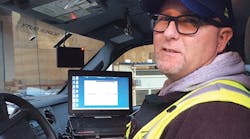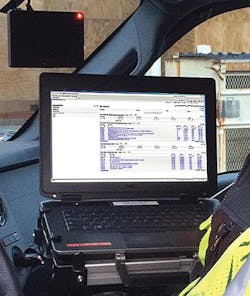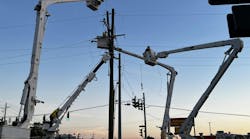At Portland General Electric, paper records and handheld radios are a thing of the past. Today, the utility is equipping its field workforce with the latest mobile technology — from smartphones to tablets to laptops — in order to improve their safety and efficiency in the field.
Within the next year, all of the company-issued phones will be smartphones as flip phones and other older technology are phased out. In addition, some employees will start using tablets in the field to look up reports and snap photos to attach to a work order.
Learning Curve
A key part of any project involves getting employees on board with the changes coming. At Portland General Electric this involved ongoing meetings with crews to talk about the changing needs of the utility industry and the importance of using new technologies at the utility to streamline, reduce paperwork and, ultimately, serve customers more effectively and efficiently.
While young apprentices may have learned how to use computers while in high school, the ever-expanding range of technological tools is all new to some of the company’s veteran linemen. For that reason, the utility offered a comprehensive training program for field employees prior to the rollout of the new software work and asset management programs, Maximo and Field Manager. About a week before the rollout, each work group spent a day in a training session where multiple instructors gave hands-on lessons on laptop computers.
As was learned during previous rollouts of new technology, questions always arise outside of the classroom environment, so ongoing technical support to field employees has become part of the plan for every project rollout. Each laptop bears a sticker with a phone number to call for 24-hour technical support. When the employees call this number, a technical support person can dial in remotely to the workers’ laptops to walk — and talk — them through a solution.
Boosting Productivity
Portland General Electric’s first responders and repairmen have been using laptops in the field for the past five years. Each truck features a specialized mount for the laptops, and often, the field workers will work on the laptops while sitting in their vehicles. The devices’ portability means they can be carried into buildings or service centers for meetings when necessary.
The new software systems are fully integrated and are replacing older stand-alone technologies. Maximo operates as the heart of the data collection system, and Field Manager enables the crews to obtain their daily work assignments electronically. The crews can also log into CGI Asset and Resource Management Scheduler, which imports job assignments and tasks from Maximo. Maximo then dispatches the information to the Field Manager system for all of the line crews and
repairmen.
With the new technology, the distribution line operations crews, planners, schedulers, contract services, inspectors and line dispatchers all work off the same platform. In the past, different departments used different software programs, which made it difficult to coordinate and communicate information. Since each worker or manager handles different types of work, their access to information pertinent to their job responsibilities is different. So, for instance, the dashboard of information visible to a supervisor is different from that of a foreman or troubleman.
Providing Optimal Routing
One of the key benefits of the integrated software program is that the field workforce can spend less time in their vehicles and on the road, and more time at the work site. Before laptops were introduced, they had to drive to the yard each work day, pick up the work packet, fuel up their vehicles, and pick up materials. Now with laptops on hand, they no longer need to stop by the yard before heading out to a job location. And the repairmen can use gas cards to fill up at any gas station or leave directly from their homes to head to a work site.
When they begin their shift, they log into the software and hit a button on the laptop computer to indicate that they are en route to a job. Then when they arrive at the job, they check in again; likewise, they check in later when they leave the job site and return back home or to the yard. That way, the utility can determine how much time the workers spent on the job and traveling to and from the work site. By capturing the data, the company can determine the cost per output, which can be valuable for later analysis.
The new software also boosts the efficiency of the customer service team. With all departments working off the same platform, there is more dynamic scheduling capability. The new system means dispatchers can send the crew closest to a work location to a particular job. And they can also reassign work if a job takes longer than expected. As a result, crews can be given more balanced workloads with a goal of more jobs being completed on schedule.
The new software also allows crews to generate a work order in the field when they see assets in need of repair. In the past, they had to write the information on an order form and then route it to the engineering department. Now the process is significantly faster because the information is electronic.
By using Field Manager on a mobile device or laptop in the field, the workers can receive, update or close out jobs electronically. The applications allow the team to have a long-range schedule, more flexible dispatching and real-time work status updates.
Improving Response Times
New technology also provides improved customer service. The new software allows faster responses to outages and emergencies, and customers can be better served because more work can be scheduled more accurately and further out into the future.
Automatic vehicle locating (AVL) systems are standard equipment in each utility vehicle now. These systems can help tremendously in many different situations. If there is a car wreck, for example, a dispatcher can use the AVL to quickly determine if a crew is in the area. Through the new scheduling software, the dispatchers can then locate a crew with the right skills to respond to an emergency. The utility also is putting automated external defibrillators (AEDs) on first-responder trucks as well as on the vehicles for line crews.
Within the last year, the utility invested in big-screen monitors for each of the line crew centers. On these monitors, the dispatchers can see in real time which vehicles are assigned to which crew. Most importantly, they can see if the crew has an AED on board as well as any other equipment that might be used to help with an emergency.
The utility’s investment in the AEDs and the workforce management system has already paid off in two different situations. In one case following an accident within a substation, a worker hit an emergency button on the radio. A crew was able to quickly respond with an AED, which saved the life of a crew member. Another time, when a car crashed into a pad-mount transformer, the dispatcher was able to send a crew with a bucket truck to that location immediately.
Collecting Data
While new technology helps expedite outage restorations and streamline communication, it also helps field managers with data collection and analysis. In today’s business environment, knowing the cost-per-output as well as the cost of each work type is critical information. It’s now possible for a supervisor to figure out exactly the cost to perform a specific task — be it replacing a lightbulb or repairing a transformer — and to calculate the exact cost of the materials and labor hours.
With the move to an electronic system, losing paper work orders, maps or other records is no longer an issue. Embracing changing technology means Portland General Electric is better equipped to meet customers’ ever-changing needs.
Rodney Lewis II ([email protected]) is a night emergency general foreman for Portland General Electric in Portland, Oregon. He has been with the company for 16 years and manages 32 first responders and two special shift line crews.
Mentioned in this article:
Dell | www.dell.com
IBM | www.ibm.com
Portland General Electric | www.portlandgeneral.com



